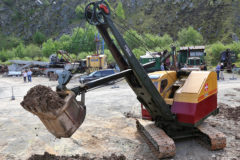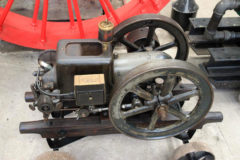Vintage JCB collection
Posted by Chris Graham on 12th August 2020
David Reed visits Derbyshire-based JC Balls & Sons and discovers a wonderful, vintage JCB collection that’s second to none.
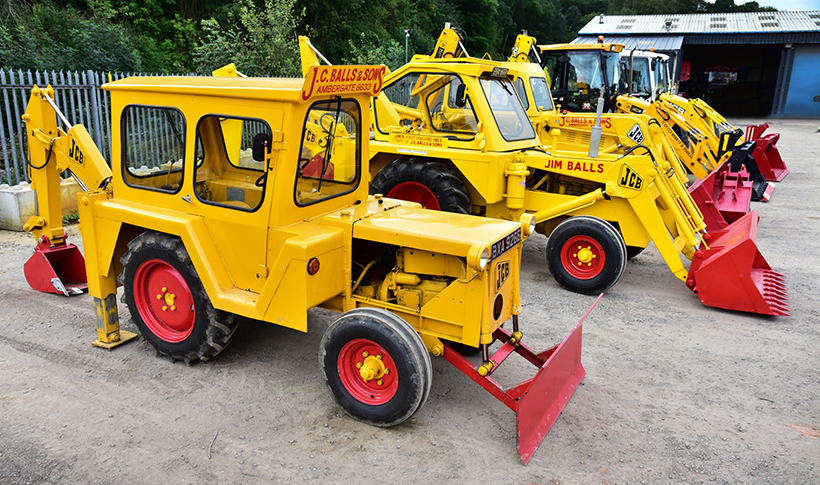
Vintage JCB collection: A 1964 JCB 1 stands alongside the other backhoe loaders in the JC Balls collection, and what a fine sight they make.
Chris and Kevin Balls, of JC Balls & Sons, have built up an exceptional collection of plant equipment, much of which comes from the JCB stable, which might not be very surprising given the firm’s initials. “We’re always looking for something unusual,” Kevin said, and they have succeeded in doing just that with a superb line-up of machines, some of which are extremely rare.
But it’s not just the JCB name that’s represented; Caterpillar, Bray and Hymac machines also make up an important part of the collection, again with some rarities among these machines, too.
The JCB story
The story of JCB products has been well-documented over the years. It all began when Joseph Bamford constructed a tipping trailer from war-surplus materials, which was made from steel sheet that had been part of air raid shelters, and it was sold for £45. The rest, as they say, is history. To start things off, the JC Balls’ collection houses one of the original trailers. “It was found on a farm at Bonsall, in the Derbyshire Dales,” Chris said.
Moving on with the JCB story, one of the first machines to be developed was the Major Loader, which was Europe’s first hydraulic loader. With one a day being built between 1949 and 1956, and initially costing £110 each, it was marketed for industrial, construction and forestry work, as well as for agricultural purposes, and was sold in kit form for mounting on a tractor.
In 1953, the company introduced the Si-draulic Loader, which was mounted on the side of a tractor and provided superior lift and forward reach, and went on to sell more than 6,000 units, at £75 each. It was also built in France, where some 20,000 units were constructed.
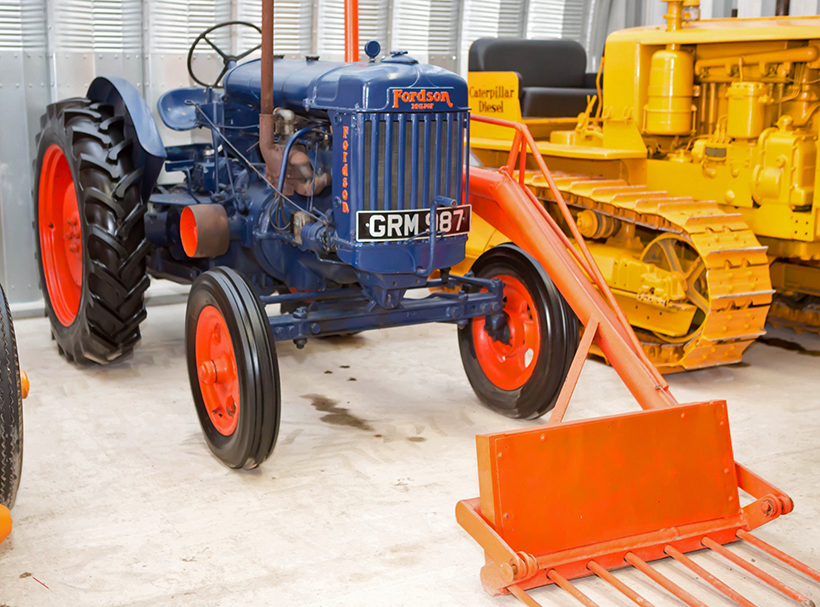
This Fordson E27N with Si-Draulic loader, was bought on eBay in the UK. Some 6,000 units were built at a cost of £75 each.
There are two of these machines in the JC Balls & Sons collection, “We bought one with a Fordson E27N that had been advertised on eBay,” Kevin explained, “and then the owner told us that he had one with a Ferguson TE-F 20, so we bought that one as well.”
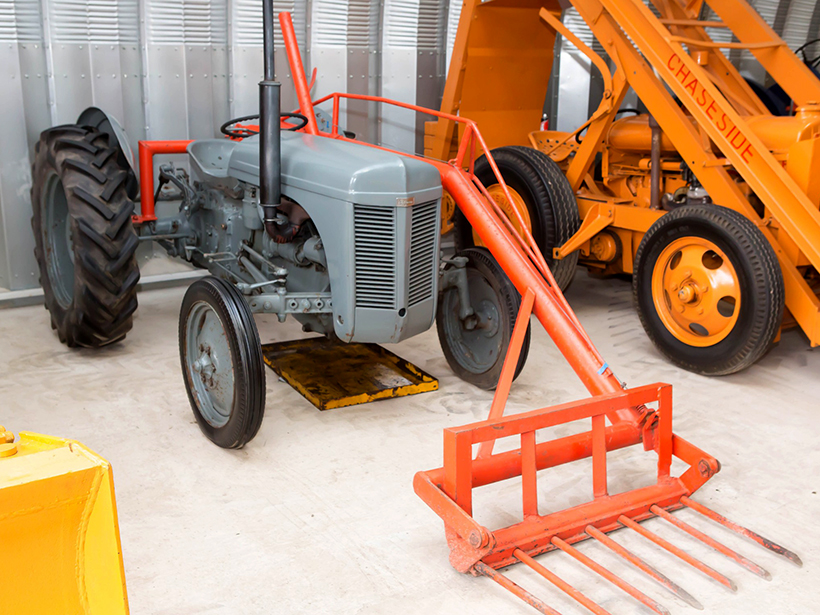
A JCB Si-draulic loader on aFerguson TE-F 20.
But it was in 1954, after a visit to Norway, that the JCB Mk1 excavator was introduced. Joe Bamford was on a business trip to promote his company’s half-track conversions for tractors, when he saw a lightweight, hydraulic, articulated backhoe that had been placed on a trailer and coupled to the back of a tractor. Instantly recognising its potential of this machine, one was brought back to the UK and, after improvements were made, the JCB Mk 1 Hydraulic excavator was born.

This 1954 Mk 1 carries the serial number 2103, and is believed to be the second oldest known to survive, despite being the 103rd example to be built.
Vital counterweight
The design included the back-hoe being fitted to an integral ‘A’ frame, that was put on to the back of the tractor, with a counterweight attached on the front although, in some cases, a compressor replaced the counterweight. But these were soon replaced with the loader arm, which resulted in the JCB Mk 1, the first ever backhoe loader; a legend was born.
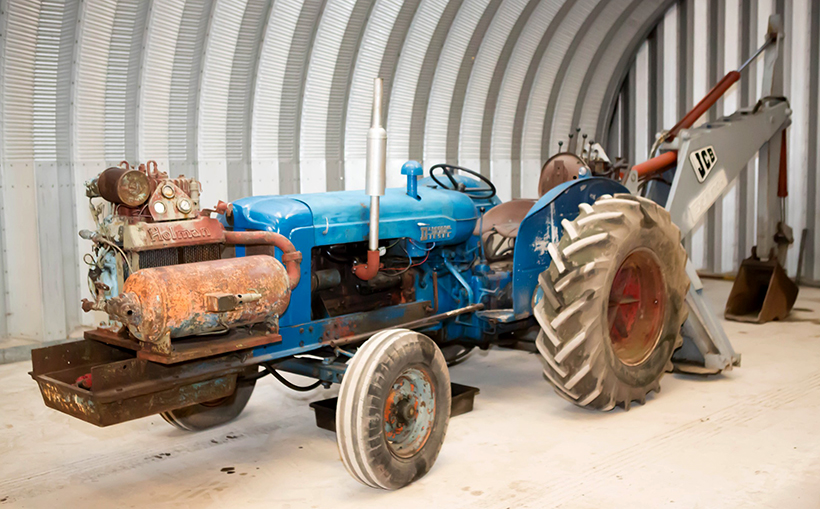
A JCB Mk 1 with Holman compressor. The Fordson E1A Mk 1 is in pretty original condition.
Kevin and Chris have a couple of JCB Mk 1s in their collection. The first is a 1954 model, and was restored in about 2006, and is fitted with a counterweight on the front. Based on a Fordson E1A Major, the combination was bought from a farm at Sleaford in Lincolnshire by Andy Jackson, with the intention of restoration. But, due to other commitments, he decided to sell it on, with Kevin buying the machine in around 1996. It was subsequently restored.
The second Fordson E1A Mk 1 came from Tim Starkey-Smith, and looks to be pretty original. “This is how it came to us,” Kevin said, “and we’re undecided about restoring it in the future. We may just leave it as it is.” Replacing the front counterweight on this example is a rather work-worn Holman compressor, which Chris says has been run.
After the Mk 1, JCB introduced the Hydra Digga in 1957 which, in turn, was combined with the Loadall to make the Hydra Digga/Loadall, that went on to sell over 2,000 units before production ceased in 1960. Larger and more powerful than its predecessors, it was advertised as ‘the earth mover that could dig through rock.’ As well as its improved boom and dipper, it was the first to provide the operator with a comfortable cab, and became the first, mass-produced backhoe loader in the UK. Latterly named the Loadall 65, it was the first JCB to feature a hollow chassis that was used to store hydraulic oil – a feature that all JCB loaders utilised until 1990.
Registered 1238 EL, the Loadall 65 in the JC Balls’ collection definitely catches the eye. Built in 1959, and carrying the chassis number of 5043, it’s in superb condition – thanks to Tim Starkey-Smith’s restoration. “We bought the Loadall from him,” Kevin said, “and haven’t done a thing to it since, apart from painting it with our name.”

The 1959 JCB Hydra-Digga Loadall 65 in ‘as found’ condition…

… now it’s partly restored and starting to look very good. Currently, it’s waiting for its cab to be fitted.
JCB 4 Series
The successor to the Hydra Digga Loadall was the JCB 4 Series, which was the first to feature dual hydraulics and a two-lever excavator control system. In was initially based on a Power Major skid unit, which was changed to a Super Major in 1961. It featured a JCB front axle arrangement, while the 4D also boasted longer loader arms and a new cab. By 1968, the JCB 4D Mk II was introduced with a Nuffield/British Leyland 4/65 engine providing the power. Weighing in at eight tons due to its larger loader and bigger buckets on the backhoe, it didn’t sell that well, with only 400 units being sold.
There’s one in the JC Balls’ collection, though. Registered CCA 911L, the 4D Mk II dates from 1972-73. “We bought this one from a farm in North Wales, after it had been advertised on eBay,” Chris explained. The attraction of the 4D to Chris and Kevin is its rarity. “You just don’t see many of them about,” Chris said. The 4D Mk II is in an unrestored condition, although its time will come in due course. “Just about everything that we have will be restored, eventually,” Kevin said.
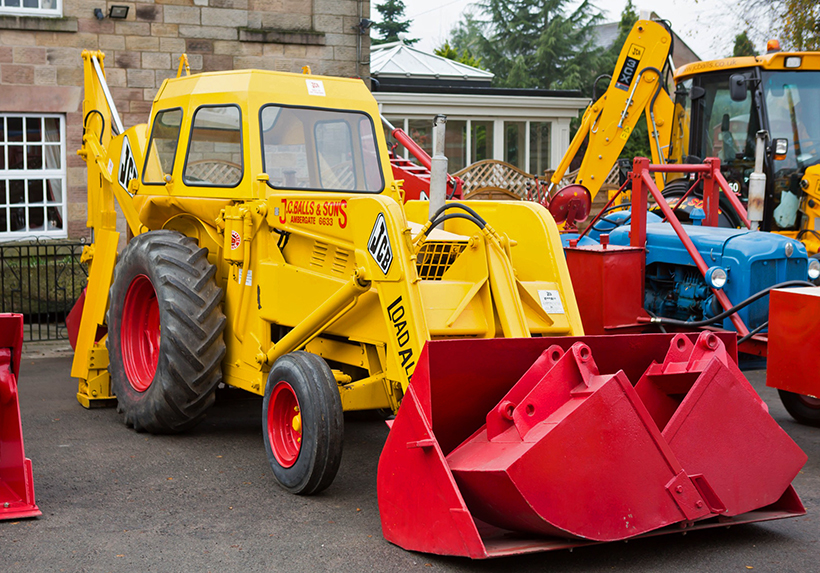
This JCB Hydra-Digga Loadall 65 is in superb condition. It was built in 1959 and was one of over 2,000 units that came off the production line.
But the backhoe loader that became iconic just has to be the JCB 3, and its later derivatives. Introduced in 1962, it featured a Hydra chassis, and a Super Comfort Cab and, of course, there’s one in the JC Balls collection. Registered 284 WRR, their example dates from 1963, and it has a significant place in the history of JC Balls & Sons. Although it’s not the actual JCB 3 that Jim Balls started his business with back in 1963, it does carry the actual registration number, and has been restored to the same specification as his first machine. Again, the restoration is superb, with the JCB looking just as good as it must have done when the original was first delivered to the company. As for its restoration, it was actually built up out of two, donor machines.
1960s market leader
The JCB 3, and the following 3C introduced in 1963, became the market leader for JCB over the years. The example in the collection dates from 1965, and is registered CVG 950C. It’s unrestored, but is a well-known machine, although you might not realise it. Chris explained: “It was the one that Corgi measured when it was developing its JCB 3 model,” Chris said. There are a few features that actually made it to the finished model. “When they came to measure up the actual 3C, the front strengthening bar on the top of the bucket was included,” Chris explained. “The 3C also had an indicator light missing on the side of the cab, and that’s also omitted on the model.” However, no history is known about this 3C.
The JCB 3D Mk II was introduced in 1967, and was based around the BMC Nuffield 10/60 skid unit. HTU 589K is the registration of JC Balls’ example that dates from 1971-72, and wears the yellow and white livery that was applied to JCB backhoes at the time. It’s been superbly restored, but not by the JC Balls team. But, although it’s in great condition, there was a discrepancy with the restoration. “It is not actually fitted with a JCB 3D cab,” Kevin revealed. JCB was obviously thinking about the operator when it developed the 3D cab, as it had some interesting features. “It was sold with a plug socket and a kettle, so that the driver could make himself a drink,” Chris added.
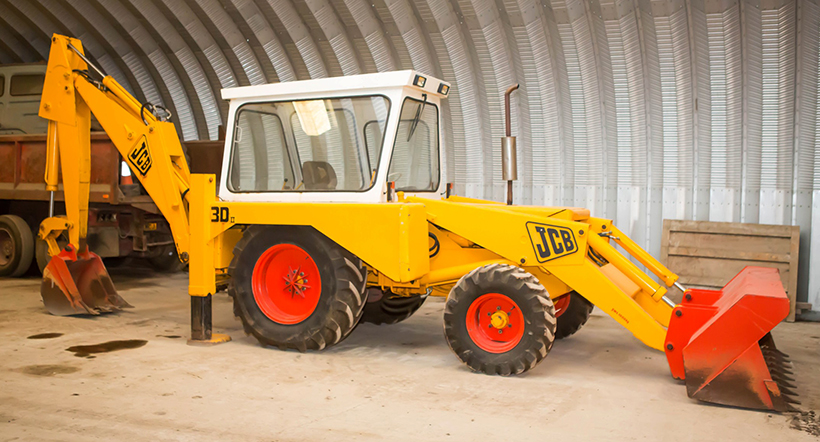
Registered HTU 589K, this 1971-72 registered JCB 3D Mk II wears the yellow and white livery that was applied to JCB backhoes at the time. It’s been superbly restored, but not by the JC Balls team.
The 1964 JCB 1 ‘Gravedigger’ model was built on a smaller scale. Introduced in 1963, the idea behind the JCB 1 was for it to be used by building contractors, although it found plenty of work with local authorities as it proved to be ideal for grave-digging duties, hence the nickname. Powered by a 20hp Petter PH2 engine, it was fitted with a rear excavator, but only a blade at the front, which was mainly used for back filling. Production came to a close in 1970.
A working example
Kevin and Chris’ example – registered BXA 926B – dates from 1964 and, once again, has been superbly restored. Although not new to JC Balls, it did become part of the working fleet. “It was used for small jobs and, when its working days were over, we just kept it,” Kevin said. The JCB 1 ended up being displayed in an unusual place, though. “The pub just up the road was renamed The Excavator,” Kevin continued, “and the actor, Bill Maynard, drove the JCB 3C up the road to officially open it.”
As for the JCB 1, that was displayed on the roof of the pub, where it stayed for a few years. The Excavator pub is still there, but the JCB 1 has now gone. It’s been fully restored and is now part of the ‘Digger Dancers’ team that entertains visitors at many shows during the summer months.
The development of the backhoe loader continued with the ever popular 3CX being introduced in 1980, after many years of development. There are a couple of stand-out examples of this machine in the JC Balls & Sons collection. The first dates from 2005, and is a JCB 3CX 60th anniversary edition. Only 60 machines were built to commemorate this milestone in the company’s history, with this example only used for display at shows. To compliment this one, there’s YT16 SVP, a 2016 JCB Platinum Edition 3CX that was built to commemorate JCB’s 70th anniversary. Again, it was a limited edition with only 70 machines built; one for every year that JCB had been in business. To bring back some memories, it wears the striking yellow and white livery that was last seen on the JCB 3C Mk III, back in 1979.
A mysterious tug
Moving away from the backhoe loaders, an interesting JCB machine in the collection was a tug. “No detailed history is known about this JCB Tug,” Chris said, “but we do know that Joseph Bamford flew aircraft, so it’s possible that it was used to move his plane around.” Being based on a JCB 4 gives us a clue to its probable age, but what’s known is that it started its life in England, but was restored in Ireland, before becoming part of JC Balls & Sons fleet.
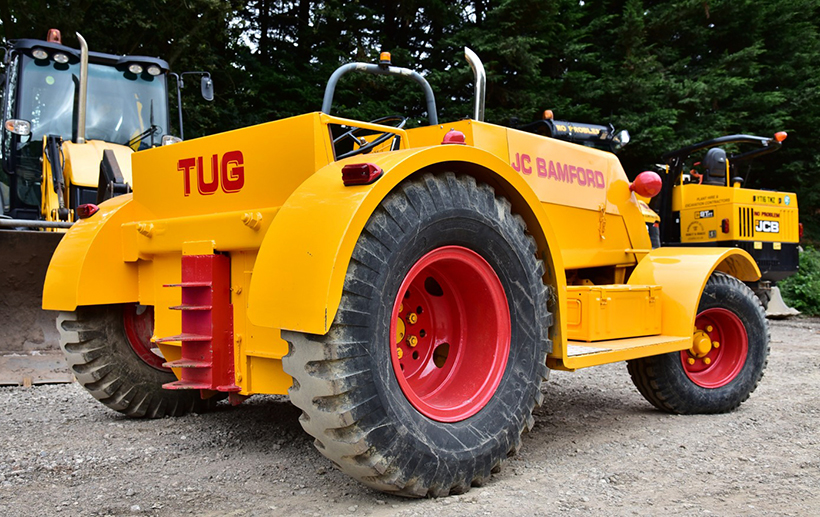
No detailed history is known about this JCB Tug, but Joseph Bamford flew aircraft, so it’s possible that it was used to move his plane around.
Also, in superb condition is a circa 1943 Chase side-loader, that was bought from the March 2018 JCB auction. “It was displayed in front of the JCB offices at one time,” Chris said, “and then seems to have been stored by JCB for 50 years, before being put up for sale.”
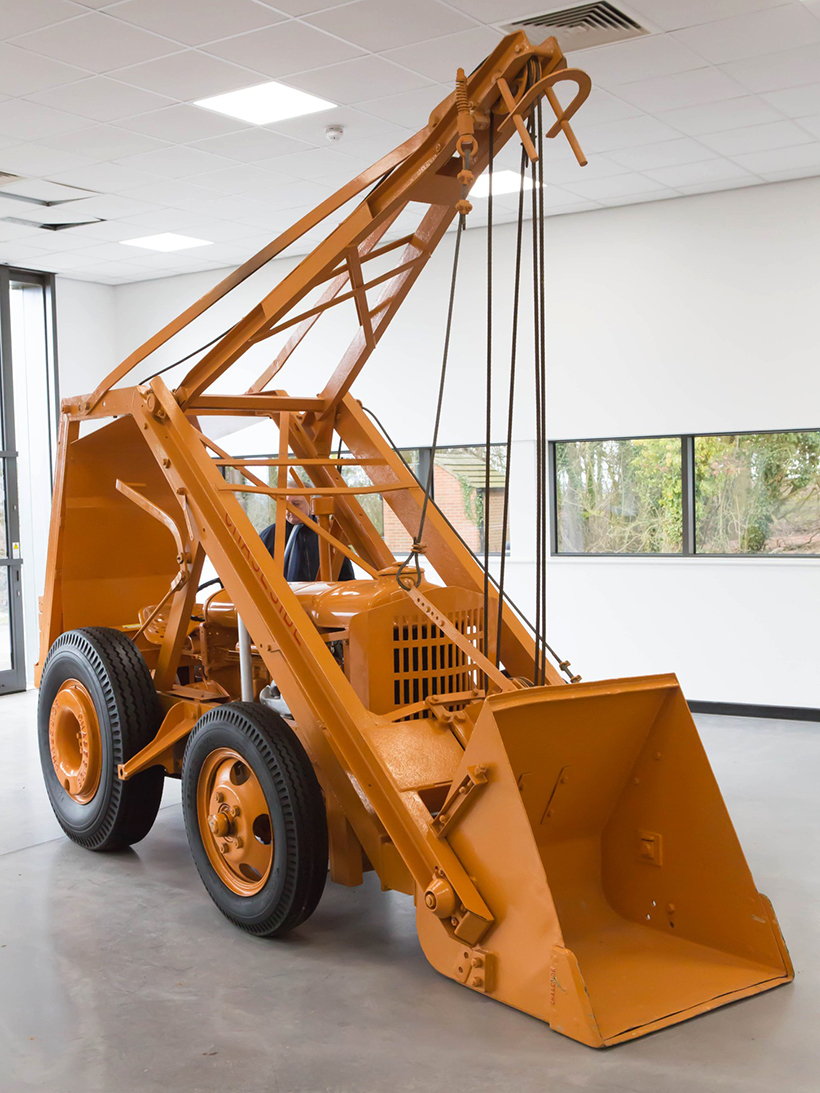
This c.1943 Chaseside loader was sold at the JCB auction in March 2018, where it was described as having been in storage for 50 years.
Hiding in a corner of a shed was a 1968 JCB 1000 loading shovel that also has a Chaseside connection. That company was taken over by JCB in 1968, and the seven-model loading shovel range was re-badged ‘JCB’. The 1000 was introduced in 1968, then was replaced by the 1250 in 1970. As for Chris and Kevin’s example, it was withNigel Green of Tansley, near Matlock, before passing into the JC Balls & Sons collection and, although unrestored, it’s in working order.
Then there were a couple of excavators that definitely were worth a second look. The first was a very original JCB 6D dating from 1968; the year that the model was introduced. This model was an improvement on the JCB 6C and, although both were powered by a six-cylinder, 106hp Perkins 6.354 diesel engine, the 6D boasted a wider undercarriage. Having only had one previous owner, the JC Balls & Sons’ 6D was found on a farm at Newark, in Nottinghamshire, where it had latterly been stored in a barn. “We bought it about 10 years ago,” Kevin said. “It’s all in working order.”
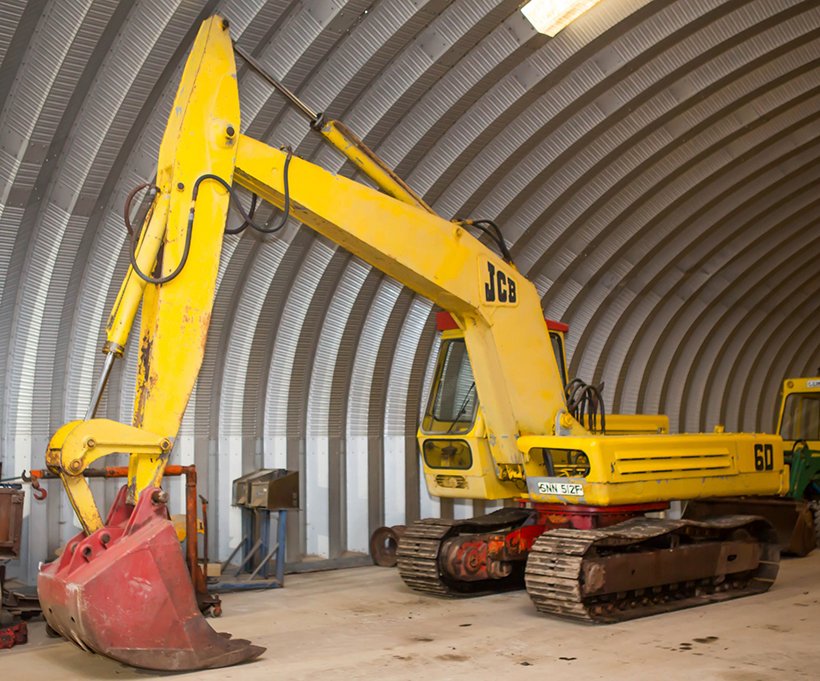
The JCB 6D excavator was introduced in 1968, which is the year that this one was manufactured. In original condition, it has only had one previous owner.
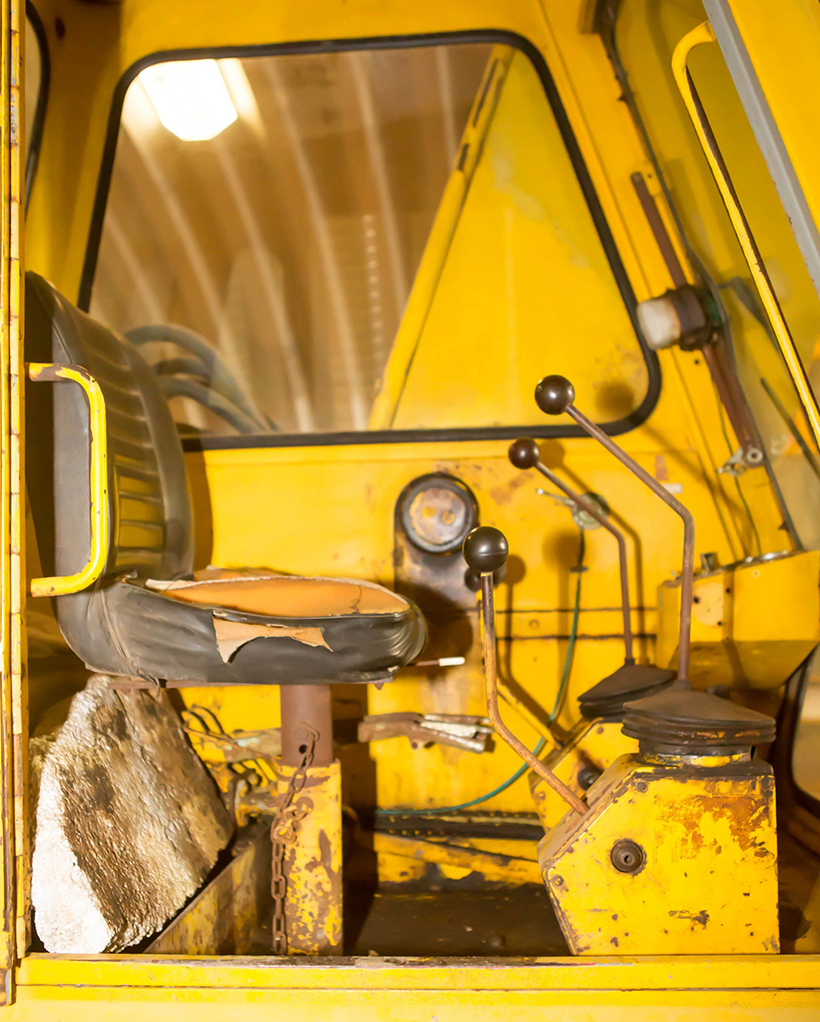
This JCB 6D looked a little work-worn inside the cab, but the condition was pretty good considering that this excavator is over 50 years old.
For a money-saving subscription to Old Glory magazine, simply click here



